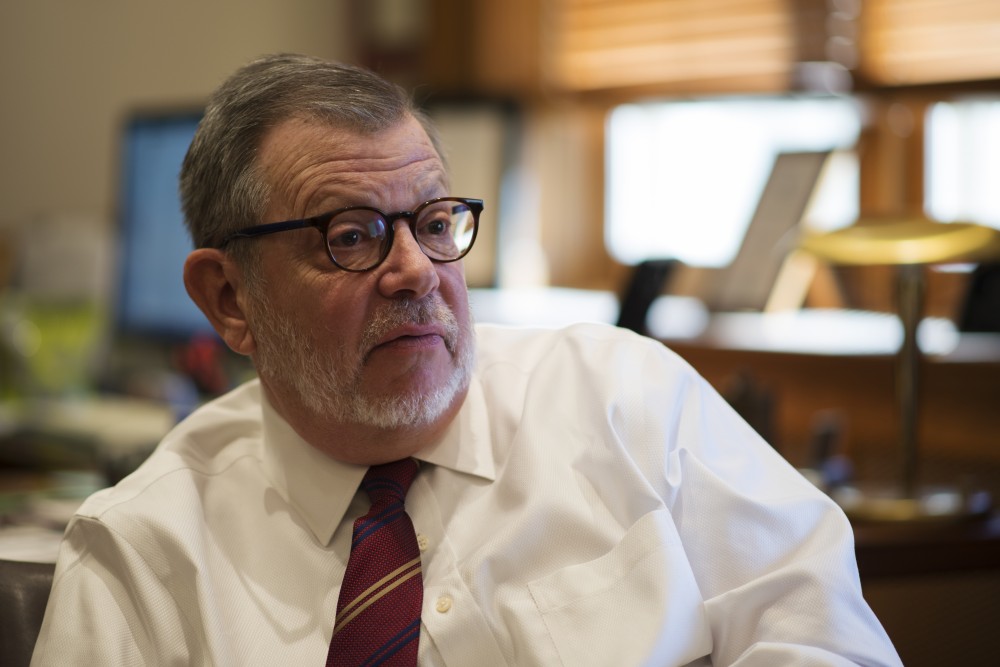The University of Minnesota’s plans to combat sexual misconduct set out with an ambitious goal: to stop the “epidemic” of sexual assault and harassment on campus.
Nearly two years into the President’s Initiative to Prevent Sexual Misconduct, University officials see signs of success, although they say there’s more work to be done. The campaign, which costs the University more than $740,000, features a wide-range of efforts, from mandating employee training to increasing bystander intervention.
Last spring, the University implemented required sexual misconduct training for all faculty and staff systemwide. The school has also revamped online sexual assault prevention training for students, launched an $80,000 public awareness campaign and started a series of sexual harassment workshops for department heads and academic leaders.
“This is the largest university in the country right now that is doing something this extensive,” said School of Public Health Dean John Finnegan, chair of the initiative. “We have really brought together, I think, a critical mass of energy that can help propel culture change.”
Through this spring semester, the University will emphasize bystander intervention training and student engagement, said Maggie Towle, interim vice provost for student affairs and dean of students. With the help of a new staff member hired last fall, the University is planning trainings with specific communities on campus, including Greek life and athletics, she said.
Although the campaign is funded through the end of the academic year, those in charge are hopeful efforts will continue when President-Designate Joan Gabel takes over in July.
Gabel praised the University’s public health approach to sexual misconduct during her visit on campus in December, saying the University should continue to take a leading role on preventing sexual misconduct when she’s president.
Finnegan said the past two years mark only the beginning phases of this work.
“What we’re moving toward is embedding this effort within the university, within its community and the structure of the university, in such [a] way that it’s now going to be something we can sustain in the long-run,” he said.
Signs of progress, but more work ahead
“Stopping sexual misconduct on our campuses begins with every one of us.”
Those were the words University President Eric Kaler used when he launched the campaign in 2017. The efforts — a top priority of Kaler’s presidency — take a public health approach, which looks to address the deep-rooted causes of sexual misconduct.
Two years in, there’s now measurable progress. Officials leading the campaign say they’ve received widespread support and crucial buy-in from faculty, staff and students on campus. But they also acknowledge they still have a long way to go.
“I’ve been nothing but pleasantly surprised by how much support we’re getting across the board,” said Dave Golden, director of public health and communications at Boynton Health, who oversees the campaign’s evaluation and research.
He pointed to the more than 99 percent of faculty and staff who completed the online sexual harassment training as a sign of progress. Even so, in a post-training survey, faculty and staff expressed relatively low confidence in the University’s ability to prevent retaliation and respond to sexual misconduct.
However, the campaign has also highlighted areas of concern, particularly the prevalence of sexual harassment among students and employees alike. The University has long measured incidents of sexual assault, but only began collecting data about harassment among students and employees in 2018.
Nearly 30 percent of faculty and staff say they’ve experienced harassment at the University, according to data collected in last year’s mandatory employee training. Boynton’s 2018 College Student Health survey found even higher rates of harassment reported by students — nearly three out of four students on the Twin Cities campus say they’ve experienced sexual harassment.
Reports of sexual misconduct to the Office of Equal Opportunity and Affirmative Action have continued to rise.
Finnegan said the increased reports of sexual misconduct may be “a form of success,” indicating people could feel more comfortable reporting incidents, instead of staying silent.
But Finnegan acknowledged the campaign needs to look at the deep-seated causes of sexual misconduct, including the University’s culture.
“We asked the question: if we have, like every university, a culture that has allowed this kind of behavior to fester, what is about the way that we have constructed the institution that has allowed it to happen,” he said. “What are the policies, what are the processes, what are the cultural values that have allowed this kind of stuff to go on?”
However, officials leading the campaign say solving those problems is going to take some time.
“We’re in this for the long-haul,” Golden said. “This is not just something that you just change in a year. This is going to take years of work to change a culture.”








